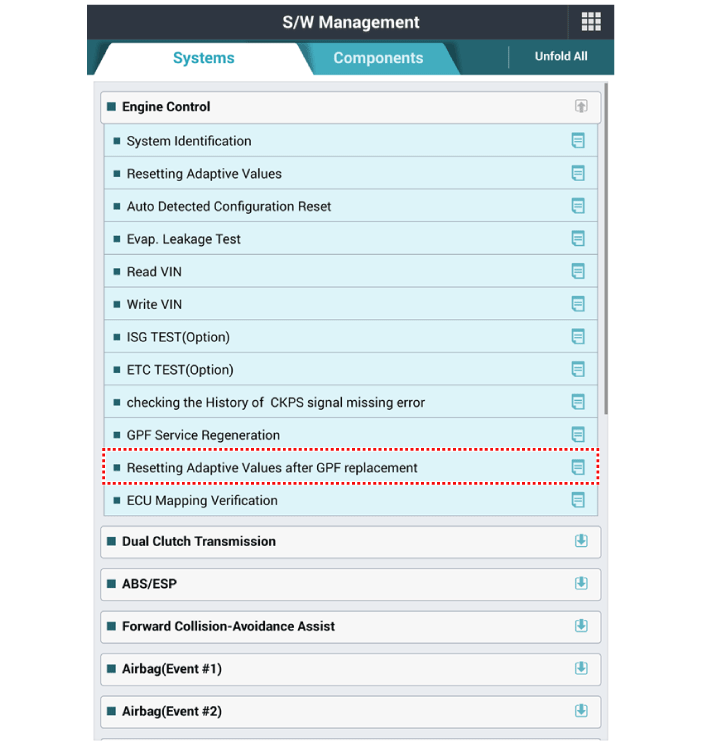Kia Picanto: Exhaust Emission Control System / GPF (Gasoline Particulate Filter)
Kia Picanto JA 2017-2025 Service & Repair Manual / Emission Control System / Exhaust Emission Control System / GPF (Gasoline Particulate Filter)
Description and operation
| Description |
The
Gasoline Particulate Filter (GPF) system prevents Particulate Matter
(PM) from being discharged to the atmosphere and consists of a filter
assembly, two Exhaust Gas Temperature Sensors (EGTS).The filter is
integrated in the catalytic converter assembly and has honeycomb cell
structure which can filter the PM in the exhaust gas. While the exhaust
gas passes the GPF, This gathered PM in GPF is called "soot".

Repair procedures
| GPF Regeneration |
This
procedures is to forcibly regenerate the GPF with scan tool when the
GPF doesn't have been regenerated during driving. For example, if the
vehicle has repeated "Low speed driving" or "Short distance driving",
the GPF regeneration procedure cannot be proceeded because "Regeneration
Mode" doesn't made.
|
Forcibly Regeneration Condition
| – | Engine coolant temperature : about 70°C |
| – | Engine at idle |
| – | P-range (A/T) or Neutral (M/T) |
| – | Normal battery voltage |
| – | Electrical fully load ON (A/C ON if equipped, Blower ON with maximum speed, Head Lamp ON, Wiper ON, Other Lamps ON, etc.). |
| 1. | Turn ignition switch OFF. |
| 2. | Connect a KDS to Data Link Connector (DLC). |
| 3. | Turn ignition switch ON. |
| 4. | Select "Vehicle, Model year, Engine, System". |
| 5. | Start engine at idle and P-range (A/T) or neutral (M/T). |
| 6. | Apply
electrical fully load to the vehicle (A/C ON, Blower ON with maximum
speed, Head Lamp ON, Wiper ON, and Other Lamps ON, etc.). |
| 7. | Select "Vehicle S/W Management". |
| 8. | Select "GPF Service Regeneration".
|
| Removal & Installation |
| 1. | Turn ignition switch OFF and disconnect the battery negative (-) terminal. |
| 2. | Remove the exhaust gas temperature sensor (EGTS) #1, #2.
(Refer to Engine Control / Fuel System - "Exhaust Gas Temperature Sensor (EGTS)")
|
| 3. | Remove the GPF (C) after removing the installation nuts.
|
| 4. | Install in the reverse order of removal.
|
| Replacement |
|
| 1. | Turn ignition switch OFF. |
| 2. | Connect a KDS to Data Link Connector (DLC). |
| 3. | Turn ignition switch ON. |
| 4. | Select "Vehicle, Model year, Engine, System". |
| 5. | Start engine at idle and P-range (A/T) or neutral (M/T). |
| 6. | Apply
electrical fully load to the vehicle (A/C ON, Blower ON with maximum
speed, Head Lamp ON, Wiper ON, and Other Lamps ON, etc.). |
| 7. | Select "Vehicle S/W Management". |
| 8. | Select "Resetting Adaptive Values after GPF replacement".
|
 Exhaust Emission Control System
Exhaust Emission Control System
Description and operation
Description
Exhaust
emissions (CO, HC, NOx) are controlled by a combination of engine
modifications and the addition of special control components. Modifications to ...
 Catalytic Converter
Catalytic Converter
Description and operation
Description
The
catalytic converter of the gasoline engine is a three way catalyst. It
oxidizes carbon monoxide and hydrocarbons (HC), and separates oxygen
from t ...
Other information:
Kia Picanto JA 2017-2025 Owner's Manual: System operation
Ventilation 1. Set the mode to the position. 2. Set the air intake control to the outside (fresh) air position. 3. Set the temperature control to the desired position. 4. Set the fan speed control to the desired speed. Heating 1. Set the mode to the position. 2. Set the air intake con ...
Kia Picanto JA 2017-2025 Owner's Manual: Emergency towing
f towing is necessary, we recommend you to have it done by an authorized Kia dealer or a commercial tow truck service. If towing service is not available in an emergency, your vehicle may be temporarily towed using a cable or chain secured to the emergency towing hook under the fron ...
Copyright © www.kpicanto.com 2017-2025










